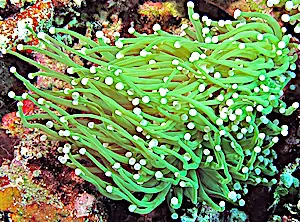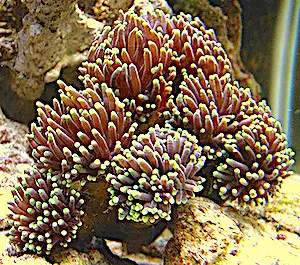Torch Coral Care Guide
Euphyllia glabrescens

| Difficulty | Water Parameters | Base Supplement | Temper | Lighting | Waterflow | Placement |
| Moderate | 72-78° F, pH: 8.1-8.4, Salinity: 1.023-1.025 dKH: 8-12 |
Trace Elements, Calcium, Magnesium, Strontium | Agressive | Moderate | Medium | Bottom |
The torch coral earned its name because it is made up of long tentacles with a single, glowing tip on each end which resembles a torch. Other names it is sometimes referred to include "Pom-Pom" and "Trumpet" coral. It is classified as a large polyp stony (LPS) type coral because it has a calcareous base, protected by large and fleshy tentacles. This coral can live more than 75 years with proper care.
In the wild, torch corals are found many places, mostly near Asia. They are found in the waters of American Samoa, Micronesia, southwest Pacific, East China Sea, southern Japan, southeast Asia, Australia, central Indo-Pacific, Arabian/Iranian Gulf, north and west Indian Ocean, Gulf of Aden, and in the Red Sea uncommonly.
Heads of torch corals may grow up to 20 inches wide in the wild, though they generally only reach approximately 10 inches in an aquarium. Tentacles typically stay around one to three centimeters apart. Tentacles will be expand under light during the daytime, and can retract into the coral's base at night. Sweeper tentacles may come out and reach several inches during the night. This is because at night the torch coral turns agressive both to protect itself by stinging, and to search for food. Common colors of the torch coral are: fluorescent green or brown tentacles matched with either green, yellow-cream, or purple tips.
Placement
Place your torch coral on the bottom of your  aquarium, either with the base stuck in the substrate, or secured on a rock. Be careful to touch only the base and not the tentacles when moving the coral because the tentacles could sting you if you have an open cut on your hand. You will want it in open light at the bottom of the tank so that it receives moderate lighting. A wavemaker or powerhead should provide medium-strength waterflow towards the bottom of the tank so that the tentacles are gently swaying in the water.
aquarium, either with the base stuck in the substrate, or secured on a rock. Be careful to touch only the base and not the tentacles when moving the coral because the tentacles could sting you if you have an open cut on your hand. You will want it in open light at the bottom of the tank so that it receives moderate lighting. A wavemaker or powerhead should provide medium-strength waterflow towards the bottom of the tank so that the tentacles are gently swaying in the water.
Make sure that your torch coral is placed about 10 inches from any other coral. This ensures that if the sweeper tentacles reach out at night, your other corals will not be harmed. If the corals are too close and stinging occurs, this will also release a harmful toxin into your water that will upset the environment.
Feeding & Supplements
Plant-like organisms called zooxanthellate live inside the torch coral and allow it to feed mainly through photosynthesis. However, the torch coral is a voracious eater and will benefit from eating occasional small amounts of meaty foods such as various shrimps, worms, clams, and fish eggs. Be cautious when feeding and ensure you do not put too much food in the tank or else you may have an ammonia or nitrate spike in the water.
Being a great water indicator, the torch coral will appear droopy when minerals in your water are excessive or not sufficient. When it appears ill, you should test your water for trace elements, calcium, magnesium, and strontium as these are the minerals it needs. Make sure there is approximately 400 ppm calcium, 1,300 ppm magnesium, and 8 ppm strontium in your water. Changing 20% of tank water and adding new reef salt mix to your water about every 2 weeks will keep trace elements replenished. If fixing these minerals does not work, test your water for alkalinity, ammonia, and nitrate. Make sure your alkalinity is between 8.3 and 9.3 on a Kh scale, your nitrate is .2 ppm or less, your phosphate level is .05 ppm or less, and that your ammonia is 0 ppm. If these elements are off they will damage the health of all your corals and tank livestock, and are probably the culprit to why your torch coral is sick.
Compatibility

The torch coral is compatible with most marine livestock as long as it is positioned 10 inches from other coral to prevent agression. Sometimes a frogspawn or hammer coral will be fine placed closer to a torch coral as they are similar type corals and likewise agressive. However, we cannot be sure that yours in particular will get along. If you try placing those corals together, it will be by chance if they get along or not, and could result in death of one or both of them.
Fish will usually get along fine with torch corals. Though if a fish upsets the torch coral by pestering it, stinging could occur. Have great caution with your torch coral, and watch how it handles your fish. Fish such as mandarins, blennies and clownfish are great to have in the same tank as a torch coral because they have sting-resistant mucus on their body. Clownfish may even host a torch coral since it resembles an anemone with its long tentacles and stinging ability.
Reproduction & Breeding
Natural reproduction will occur for torch corals if they are well-maintained. It will need sufficient minerals to allow it to build new skeleton. It will need proper light and waterflow. Supplement feeding will accelerate the coral growth. When satisfied, the torch coral will expand itself by growing new heads off its base, known as "budding". Reproduction can also occur when female and male colonies release eggs and sperm into the water column. However, this way is less likely to occur since you would need multiple colonies.
To propagate your torch coral, you will need a sharp tool such as an X-Acto knife. Cut the skeleton two or three inches below the head. Make sure you cut the skeleton only, and not the slimy parts of the base as that would hurt the coral. Move the separate pieces back into your tank when done.